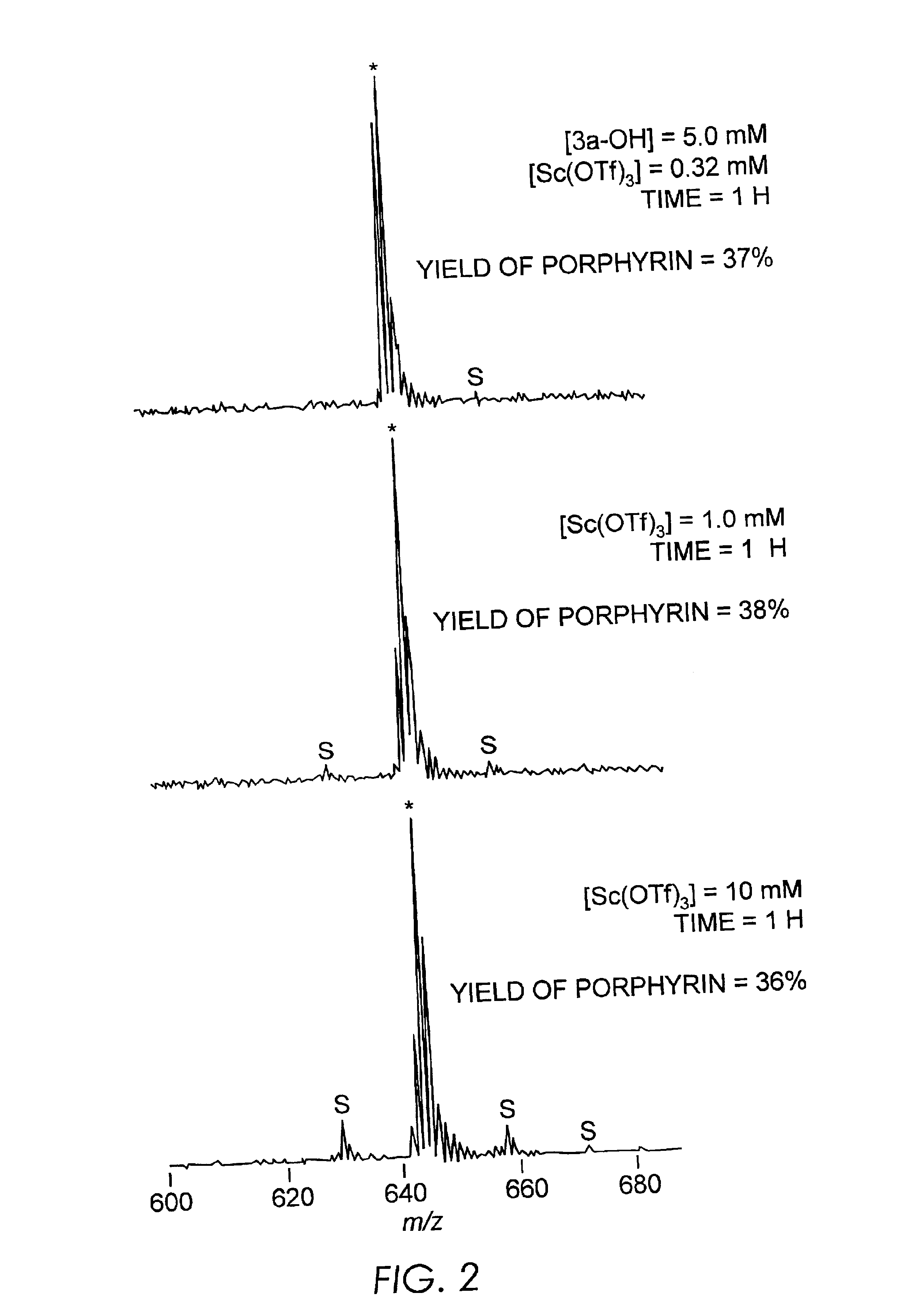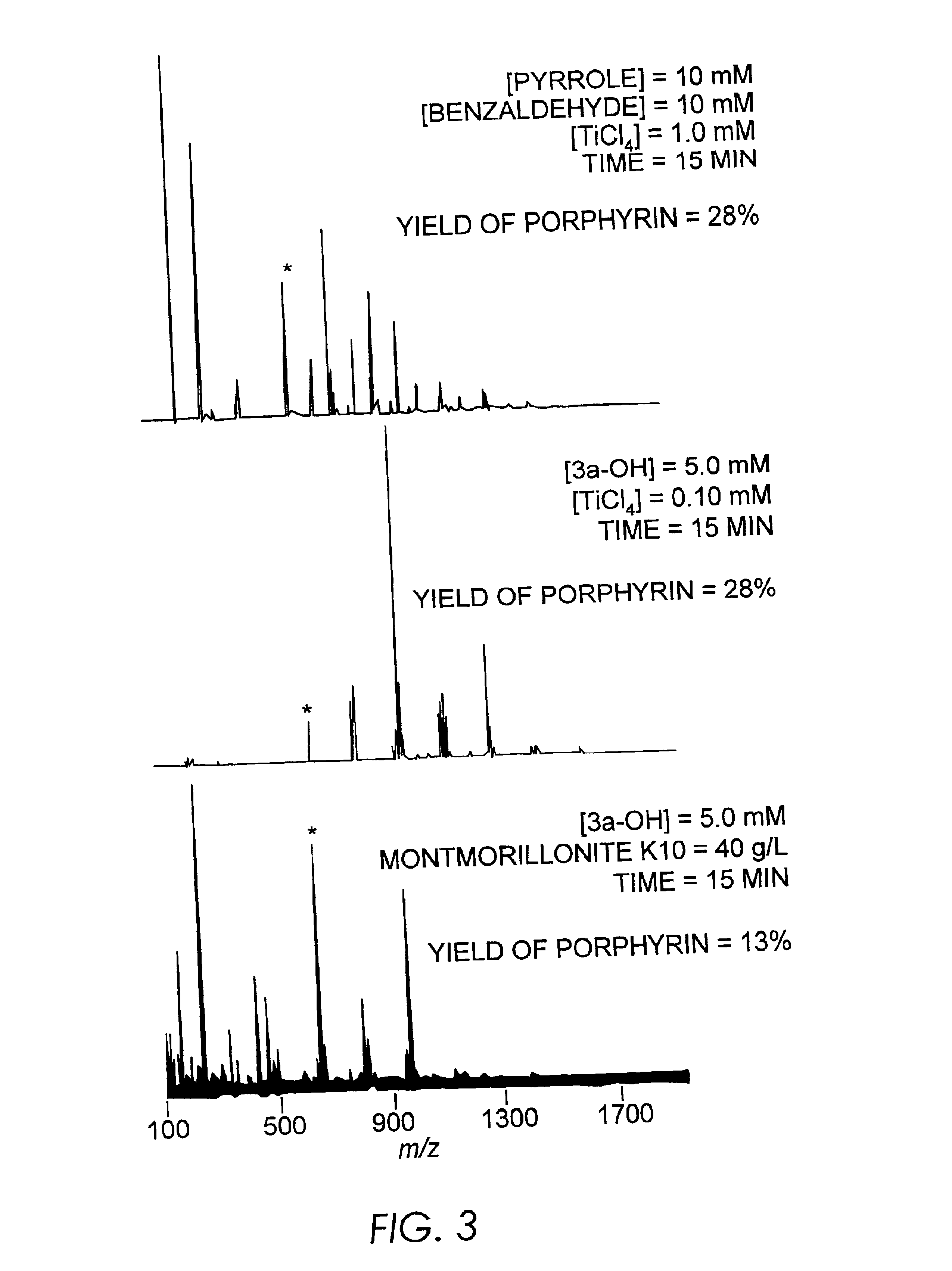Methods of making porphyrins and related compounds with Lewis acids
a technology of porphyrin and related compounds, which is applied in the field of making ring compounds, can solve the problems of poor suitability of catalytic conditions traditionally clsub>2 /sub>as solvent, and the limitations of traditional catalytic conditions used in the synthesizing of porphyrins from pyrrole+
- Summary
- Abstract
- Description
- Claims
- Application Information
AI Technical Summary
Benefits of technology
Problems solved by technology
Method used
Image
Examples
examples 1-15
Results and Discussion
I. Synthesis of Mono and Diacyl Dipyrromethanes
The synthesis of the requisite acyl dipyrromethanes was accomplished in the following manner. The dipyrromethanes 1a-c,e, f were prepared by reacting the appropriate aldehyde with excess pyrrole in the presence of TFA (Scheme 1) (Littler et al., J. Org. Chem. 1999, 64: 1391). The dipyrromethane 1d was prepared by heating a mixture of 4-pyridylcarboxaldehyde with excess pyrrole in the absence of acid (Scheme 1) (Gryko and Lindsey, J. Org. Chem. 2000, 65: 2249).
Scheme 1R11a1b1c1d1eH—1f1g
Thioester 2a was prepared as reported previously (Rao et al., J. Org. Chem. 2000, 65: 1084). Thioester 2b was prepared in a manner similar to that of 2a (Scheme 2). Thioester 2c was prepared by treating isonicotinoyl chloride hydrochloride with 2-mercaptopyridine in the presence of triethylamine (Scheme 2).
Scheme 2R2Yield (%)2a73%2b88%2c77%
The monoacyl dipyrromethane 3a was prepared by treating dipyrromethane 1a with thioester 2a as d...
example 1
Material and Methods
1H NMR (300 MHz, CDCl3), 13C NMR (75 MHz, CDCl3), and absorption spectra were collected routinely. Elemental analyses were performed by Atlantic MicroLab, Inc. Melting points are uncorrected. Bulb-to-bulb distillation was performed using a standard-size Kugelrohr short-path distillation apparatus (Aldrich). Dipyrromethanes 1a-c,f (Littler et al., J. Org. Chem. 1999, 64: 1391) and 1d (Gryko and Lindsey, J. Org. Chem. 2000, 65: 2249), thioester 2a (Rao et al., J. Org. Chem. 2000, 65: 1084), monoacyl dipyrromethanes 3a,b (Rao et al., J. Org. Chem. 2000, 65: 1084), and diacyl dipyrromethanes 4a,c (Rao et al., J. Org. Chem. 2000, 65:7323) and 4b (Gryko and Lindsey, J. Org. Chem. 2000, 65: 2249) were prepared as described previously. Column chromatography was performed on silica (Baker, 40 μm average particle size) and alumina (Fisher, 80-200 mesh).
The acids employed in this study were of the following grades: AlCl3 (99%), BEt3 (1 M solution in hexanes), BF3-etherate (...
example 2
5-[4-(4,4,5,5-Tetramethyl-1,3,2-dioxaborolan-2-yl) phenyl]dipyrromethane (1e)
Following a general procedure (Littler, B. J. et al. J. Org. Chem. 1999, 64, 1391-1396), a mixture of pyrrole (35 mL, 0.50 mol) and 4-(4,4,5,5-tetramethyl-1,3,2-dioxaborolan-2-yl)benzaldehyde (4.64 g, 20.0 mmol) was flushed with argon for 5 min and treated with TFA (154 μL, 2.0 mmol). The mixture was stirred for 5 min at room temperature and then quenched with triethylamine. Ethyl acetate (100 mL) was added and the mixture was washed with H2O and dried (Na2SO4). Removal of solvent and excess pyrrole followed by chromatography [silica, CH2Cl2→CH2Cl2 / ethyl acetate (95:5)] gave a slightly yellow oil. Trituration with hexanes afforded a colorless solid (2.50 g, 32%): mp 129-130° C.; 1H NMR δ 7.91 (s, br, 2H), 7.77 (d, J=8.1 Hz, 2H), 7.24 (d, J=8.1 Hz, 2H), 6.70-6.69 (m, 2H), 6.17-6.14 (m, 2H), 5.91 (s, 2H), 5.49 (s, 1H), 1.34 (s, 12H); 13C NMR δ 145.1, 135.0, 132.0, 127.7, 117.2, 108.2, 107.1, 83.7, 44.0, 24.8;...
PUM
| Property | Measurement | Unit |
|---|---|---|
| Fraction | aaaaa | aaaaa |
| Molar density | aaaaa | aaaaa |
| Molar density | aaaaa | aaaaa |
Abstract
Description
Claims
Application Information
 Login to View More
Login to View More - R&D
- Intellectual Property
- Life Sciences
- Materials
- Tech Scout
- Unparalleled Data Quality
- Higher Quality Content
- 60% Fewer Hallucinations
Browse by: Latest US Patents, China's latest patents, Technical Efficacy Thesaurus, Application Domain, Technology Topic, Popular Technical Reports.
© 2025 PatSnap. All rights reserved.Legal|Privacy policy|Modern Slavery Act Transparency Statement|Sitemap|About US| Contact US: help@patsnap.com



